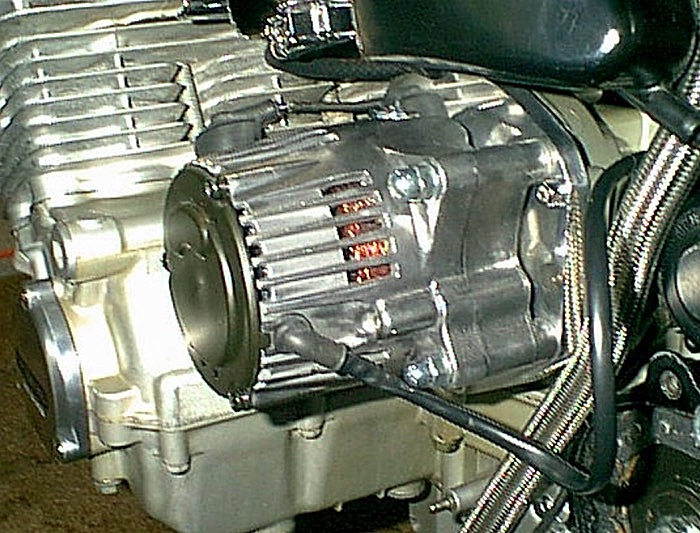- Home
- Forums
- Ride Reports
- MotoBikes
- Restorations
- Wrenching
- 1963 BMW R69s
- 1969 BMW R60/2
- 1978 Yamaha 125
- 1979 KZ1300
- 1979 Kz1300 - Bob's Beauty
- 1981 CBX SuperSport
- 1981 Kz1300 Model A3 - Chocolatie
- 1984 Ford F250 XL
- 1987 ATK
- 1987 MowieMowie
- 1987 RotoTiller
- 1988 Honda Accord Lxi
- 1990 BMW RT100 - Barrie
- 1991 Harley Davidson FLHTCU
- 1992 Johnnie Deere
- 2000 YZ426
- 2002 Dodge Ram
- 2006 Carson RacerX Trailer
- 2006 Host Camper
- 2006 KrZy8
- 2007 Wabs
- 2012 KTM 690R
- 2013 Naomi - FJR 1300
- 2014-08-01 Air Compressor - Sears
- 2017 Kioti
- 2018 Toy Hauler
- 2020 Honda Fit
- 2021 Miscellaneous
- 2024 Log Splitter
- 2024 NeoDyne MC Lift
- 2050 test
- Lil Trlr
- Eats
- RIP
- PC Not
- Cages
- Test
- FJRF Best
- For Sale
Candy Butt Association
World's Wimpiest Riders
You are here
2023-12-07 Mike Nixon - Denso Alternator Conversion
Forums:
|
The stock alternator Moreover, it's shortsighted to think of replacing the alternator without first maintaining the charging system. More often than not, charging problems have more to do with the keyswitch, wiring, connectors and fuses, than with the alternator. The CBX charging system depends on all of these to make the magnetism that creates electricity, even the Kawasaki conversion. Furthermore, most people realize that the onboard voltmeter is not a reliable indicator of charge. On a couple different levels, it can't be trusted to faithfully communicate battery condition. Consider this if the meter's behavior has been driving your disatisfaction with the stock alternator. The stock alternator's shortcomings are actually few and minor. First, its too-short brush life. This is obviously due to the brushes being positioned at the outer edge of a large diameter rotor, resulting in a fairly high surface speed, certainly higher than the brushes found in the Kawasaki alternator that are rubbing against a similar but much smaller diameter copper ring. Let me add here that I do not like the Rick's aftermarket brushes for the CBX. They appear to be modified electric tool brushes. Whatever they are they are considerably harder in material, which results in unnecessarily rapid wear of the factory rotor's slip rings. Avoid them. The factory brushes are still obtainable, though like all OEM parts they are expensive. The stock alternator also eventually fails its bearings, both the inboard and the outboard ones. As with the brushes, I don't consider this a defect either. It is to be expected, but some folks experience it prematurely in my view. My CBX never needed them in more than 50,000 miles. In any case, bearings are easily replaced. Another eventuality is leaking of the stock alternator square ring that seals it to the engine. Such is the case with almost every CBX that comes into my shop, though I believe it is due to rough handling more than anything. It's a very delicate seal. Again, this is a maintenance item, and note that the same square ring is required when fitting the Kawasaki conversion. Naturally, we can't ignore the drive discs, or alternator clutch as Honda calls it, the most famous of the CBX alternator's glitches. I may be the one who first pointed out the manufacturing defect in the engine-side disc that promotes slipping and rapid wear (I once worked for Honda corporate). In any event, reconditioning of the discs is necessary on every CBX, sometimes even replacing them, though they are long discontinued from Honda and even good used ones demand a princely sum. The bigger problem is so many folks labor under the misconception that the discs are supposed to slip. They are not. The design function is a once-in-a-blue-moon give, and just a quarter-turn at that, under extreme conditions, not repeated rotational slipping. I say shim the assembly until the discs give only in that manner. The spring preload is correct when the alternator attaching bolts will barely start on one thread with a good push on the unit. Better yet, shim even more, until the discs won't give at all, and it won't matter what condition they are in. This is functionally no different from the Kawasaki alternator which eliminates the clutch. Of course, many argue that the stock alternator is under-powered, citing the fact that the system does not begin charging the battery until somewhat above an idle. My answer is again, this is not a defect. None of Honda's charging systems of an electromagnet, modular design charge at idle. If however yours does not start to charge by 1300 rpm, the system is in need of repair or maintenance. The most common issue in this case is an alternator clutch that is slipping, though there can be other faults, the same ones that plague every charging system and are well-known and easily remedied. Speaking of faults, there is the issue of electromagnet rotor failure. It is more common than it should be. And when not detected in time the bad rotor often takes out the regulator with it. A fairly expensive repair, this, and by itself this may warrant the alternator conversion, if anything does. More importantly, it's the issue I consider the best argument for replacing the CBX's onboard voltmeter with an ammeter, which unlike a voltmeter monitors in real time, an important benefit. But few of us will experience all of these issues. At the end of the day, you can usually put your stock alternator in excellent working order for considerably less than the cost of a replacement alternator. The Denso conversion The first thing I find objectionable, and based on others' findings I am not alone, is that the installation instructions leave much to be desired. In fact they read as if written by someone who is familiar with neither the CBX's electrical system nor the Kawasaki alternator, nor for that matter spelling and grammar. Despite this, it doesn't take long to figure out that the converted alternator plugs into the wiring harness where the output side of the bike's rectifier originally did. The main gotcha here is the lack of wire color code coordination and the uncertainty this raises. The instructions should point out which of the Denso alternator's two wires is the output and which is the input, since the colors don't match the Honda's. The important thing to know is one of the conversion's wires charges the battery though the wiring harness, while the other wire receives 12v from the keyswitch to power the alternator's electromagnet. As many have discovered, switching these two wires delivers some strange results, including a dead battery. Really, the canon plug used in the alternator's cable should be matched to that on the bike. It would make this kit much more professional. This may be inconsequential but I was surprised the adapter coupling is made of aluminum. Its spline can potentially wear considerably. The good news here is few CBXs see more than a few thousand miles a year, meaning the coupling should see little wear. And no retainer for routing the attachment cable? Tacky. Some users of this conversion have observed that the lack of an oil splash guard as found at the back of the stock alternator may result in oil getting into the airbox via the crankcase breather. It has been suggested this results in spark plug fouling. If you have individual air filters this won't concern you. But most of us don't and so it might. Another small nit. But the really nagging thing with this product is the poor quality workmanship. Stacks of washers on obviously over-long bolts. An end cover that fouls the alternator's stator until modified to fit. And worst of all, the lack of good preparation of the used Denso alternator. This is evident in paint spray inside the electronics and a surprising amount of dirt in there as well. Looks to me like no prep whatsoever. Very Autozone-like, which is a little disappointing. Was the alternator even tested? No wonder this thing is sold "without warranty" (according to the installation sheet). Fortunately, the conversion works, and works well. But let's be clear, the advertised "charging at idle" is a fallacy. It does not. Not if your engine idle is a factory-correct 1000-1100 rpm. Fortunately, that's of little consequence, because as already pointed out, the stock system doesn't charge at idle either, nor does it need to. Educate yourself on this score. |
|
Firsthand experience |
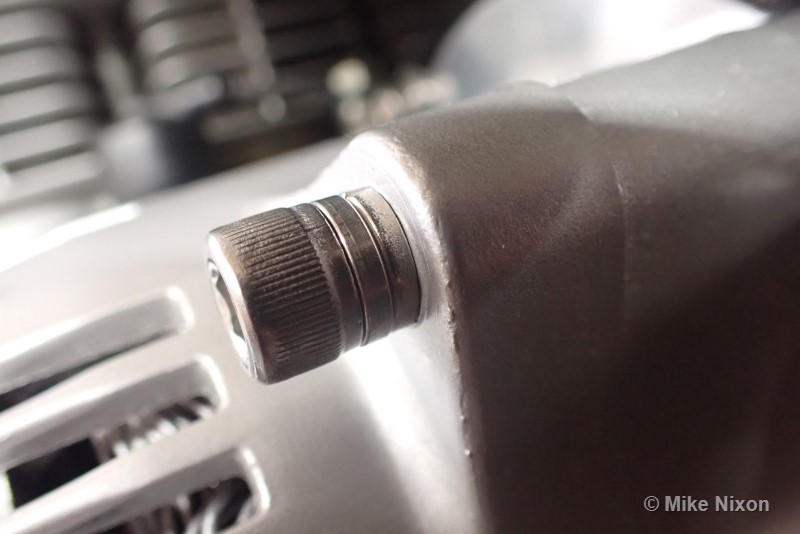 |
This is how a Denso conversion alternator, newly-purchased, came to me. Looking at this makes me cross-eyed. Call it nit-picking if you will, but this is sloppy. |
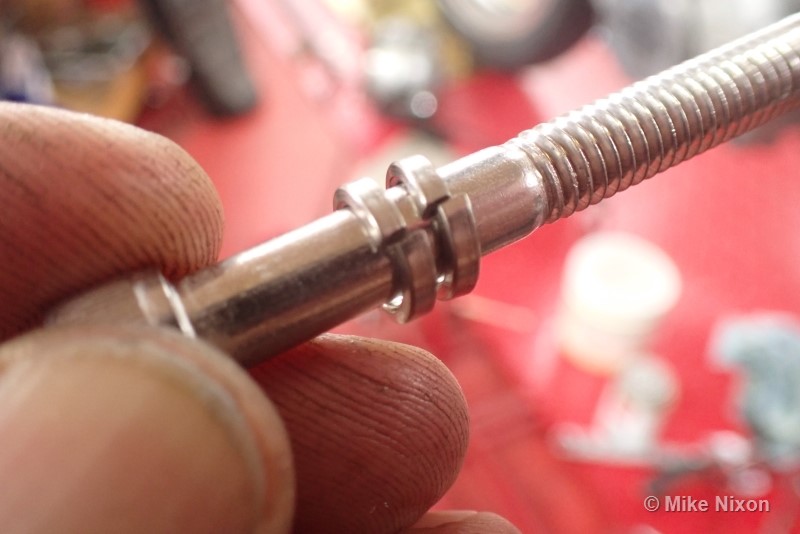 |
What is up with this? Not only is this poor mechanical practice, it resulted in just three threads engaging in the crankcase. With one of these thick washers removed, the threads were fully engaged. |
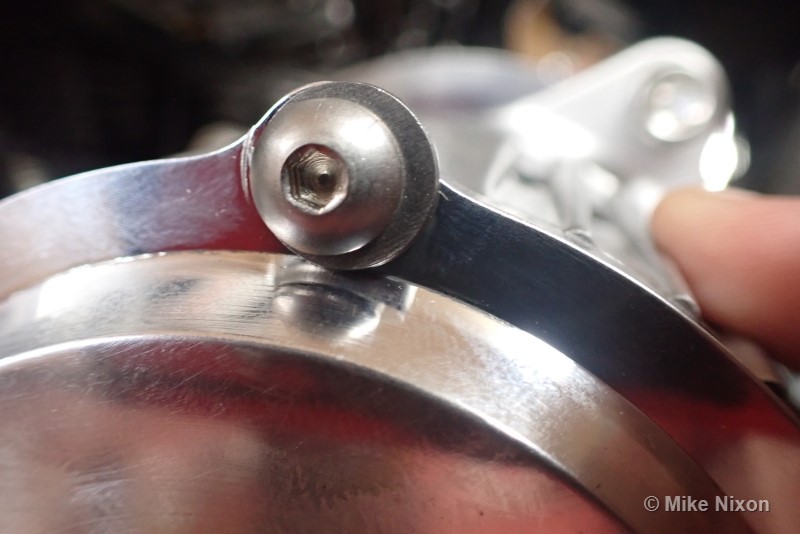 |
And here we have 5mm buttonhead Allens with 6mm washers. Uhh... |
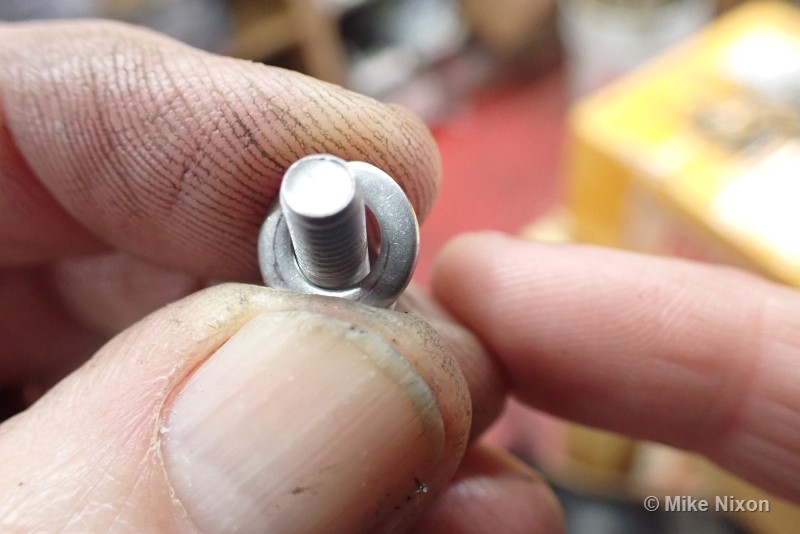 |
Had to correct this, just couldn't leave it looking like that. |
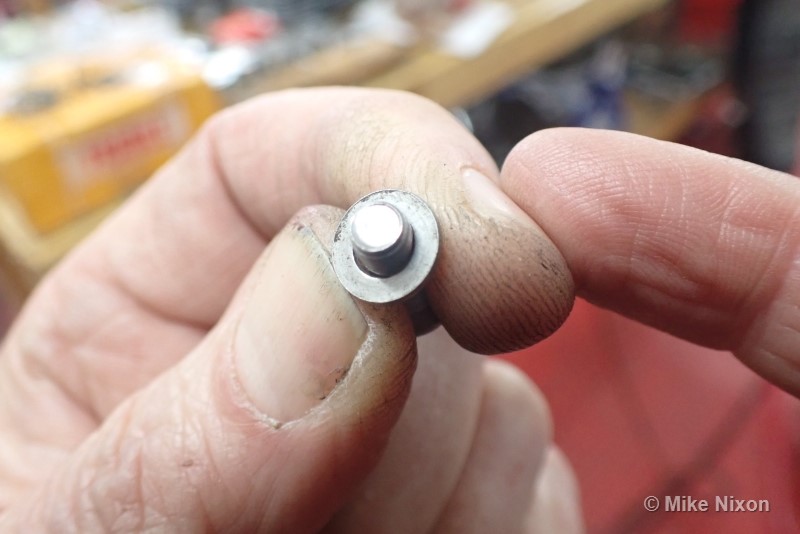 |
Better. |
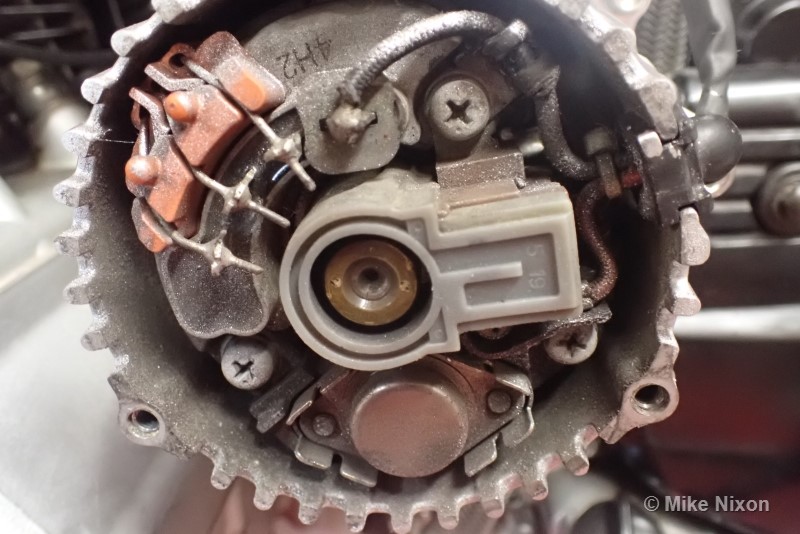 |
While the cover was off, I had a look inside. Whoa! Really? A lot of silver paint overspray. And all the dirt! |
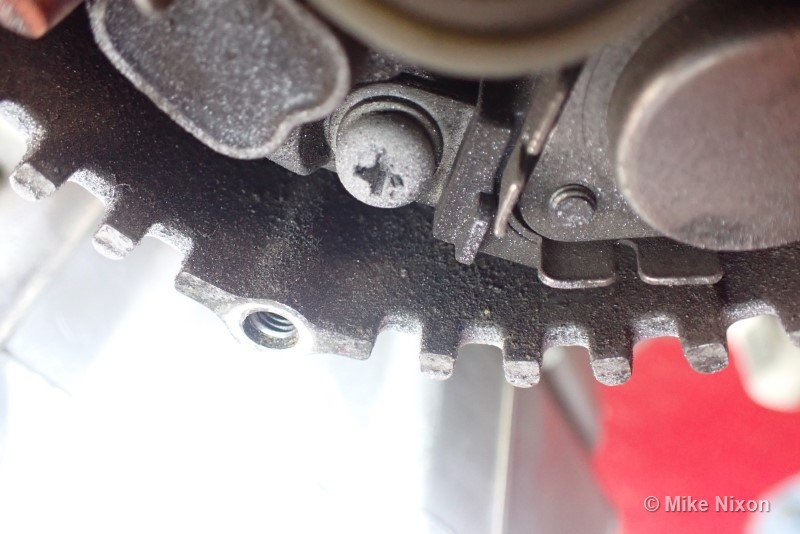 |
A closeup. Filthy, is what this is. Disappointing. |
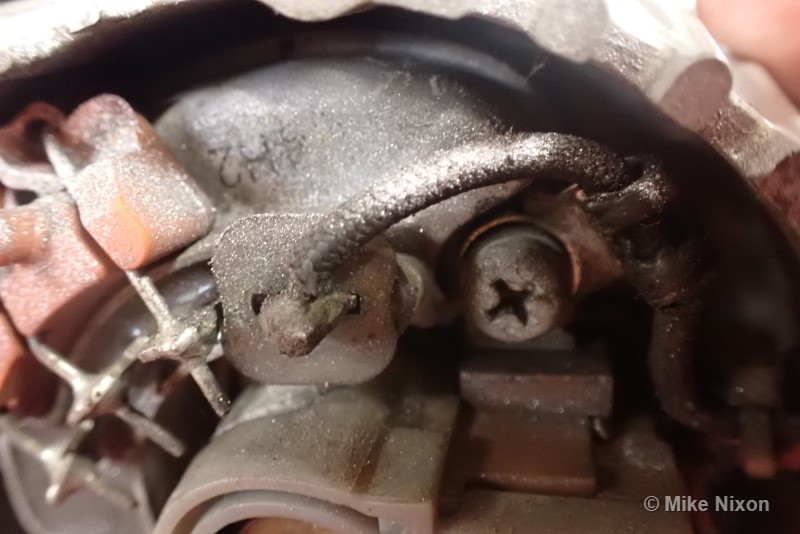 |
Paint and crud. |
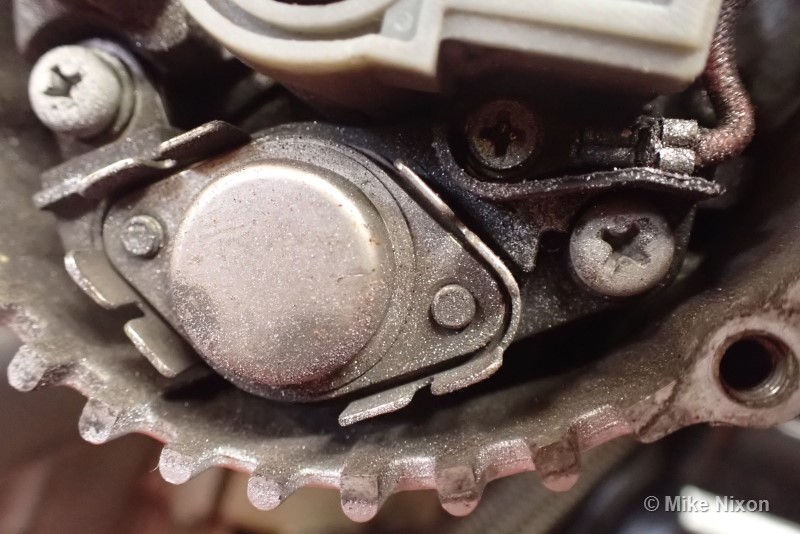 |
More paint and crud. |
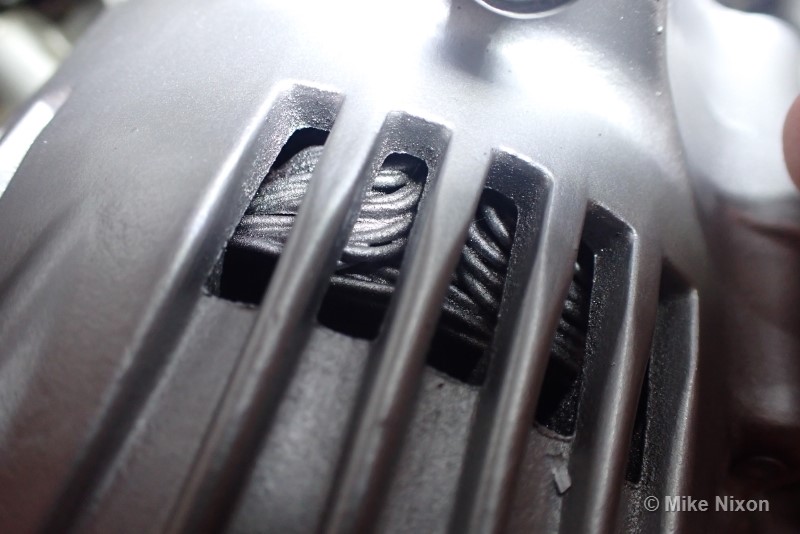 |
You can see where the paint came from. I thought only "rebuilt" alternators from Autozoneand Pep Boys looked like this. Not at all how this should be done. |
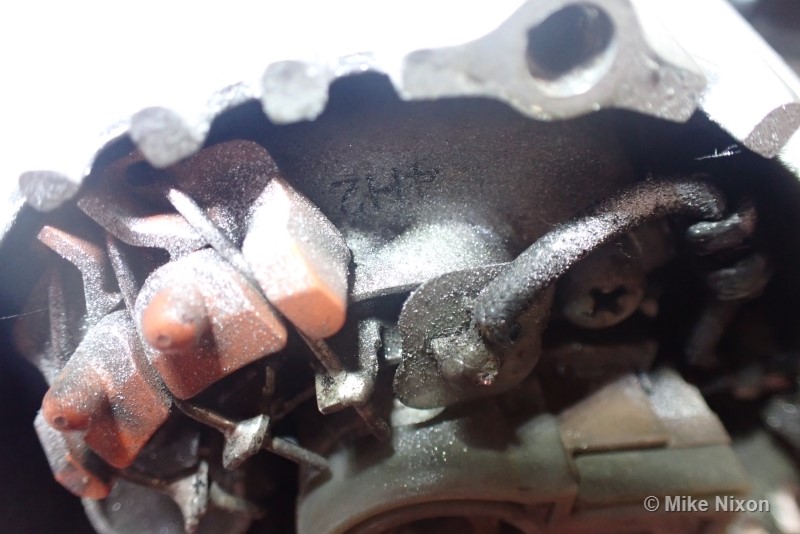 |
And yet more paint and crud. |
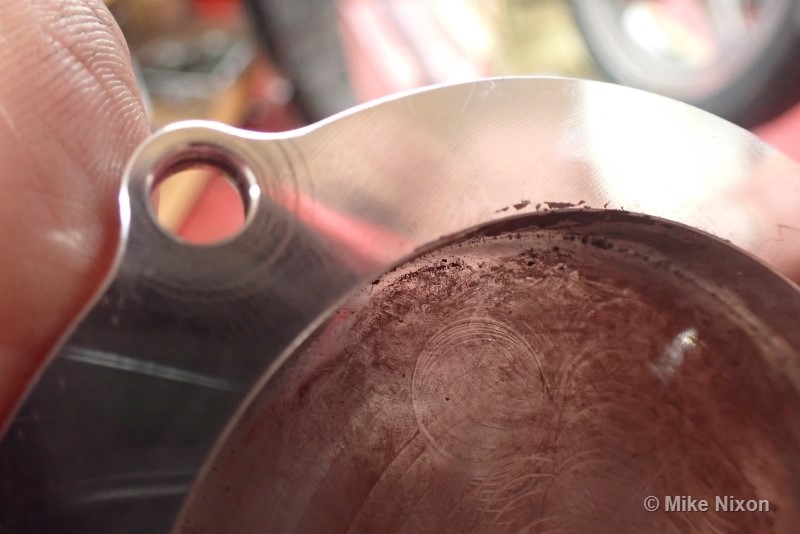 |
Putting the cover back on I find it is fighting with something, won't center itself without force. This is not right. |
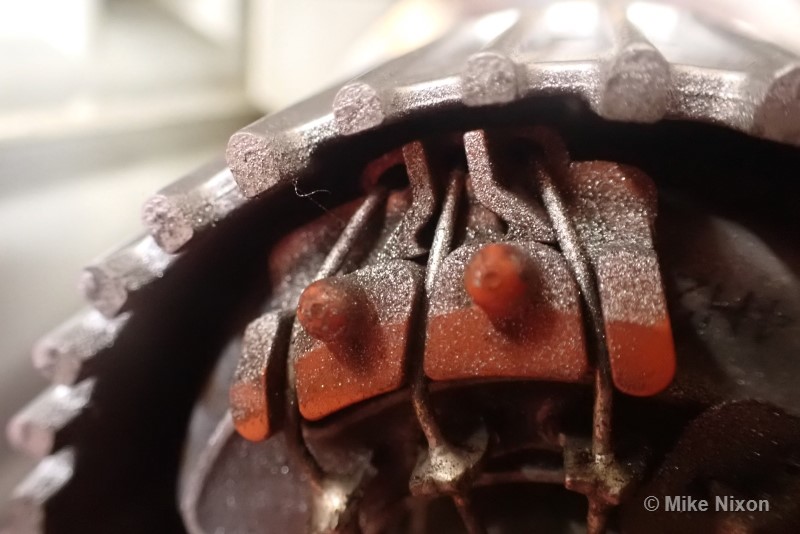 |
Hmm. The stator wiring rubber insulators are being fouled by the cover. |
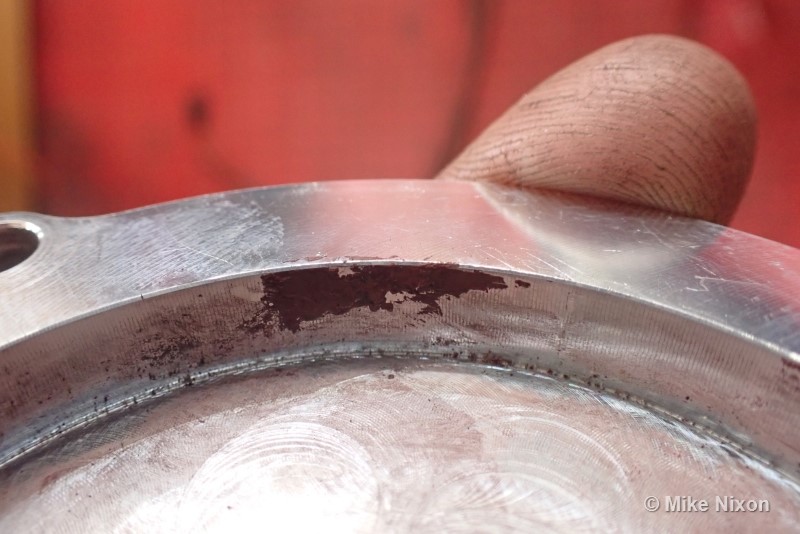 |
A little Sharpie painted on the insulator imprints onto the cover to show the interference. Sigh. |
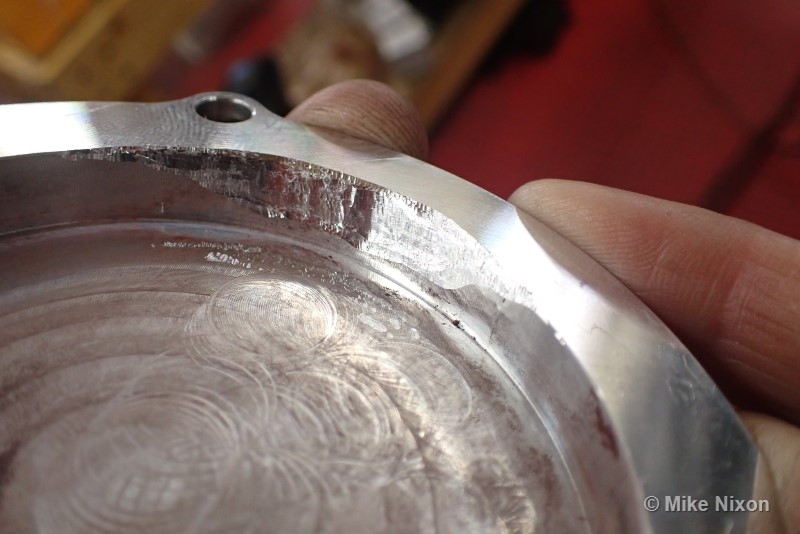 |
The cover is machined incorrectly. The correct thing to do would be to chuck the cover in a lathe and turn down the whole outer edge, make it narrower. But my customer was not planning on his "bolt-on" alternator needing machining to fit. So a little hand grinding will have to do. |
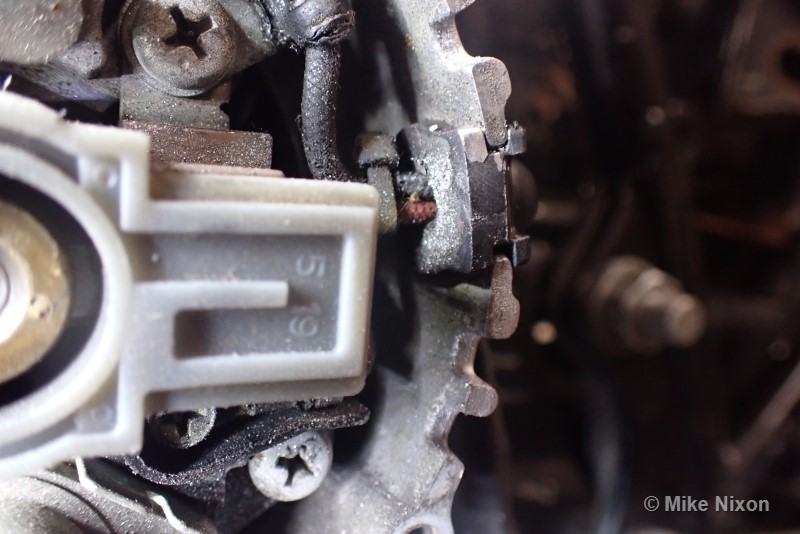 |
Nor did I get a look at the brushes on this obviously used unit to see what shape they are in. Let's assume they were replaced. |
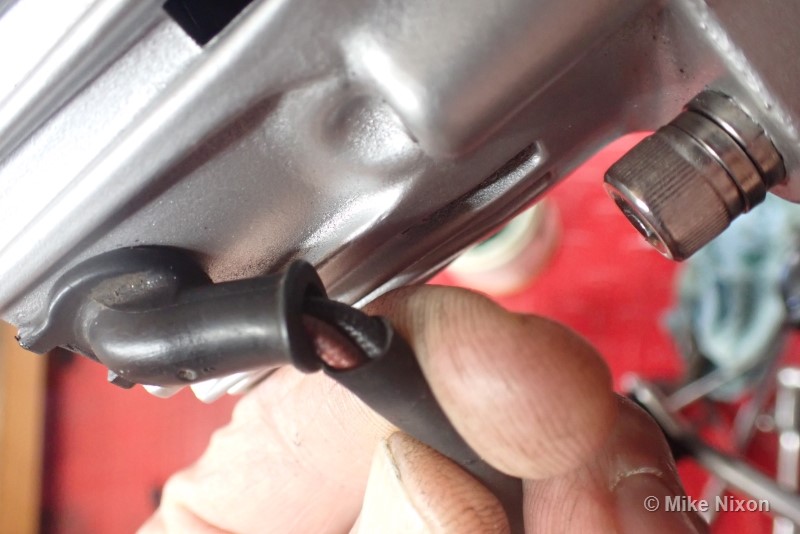 |
Note the wire color codes. |
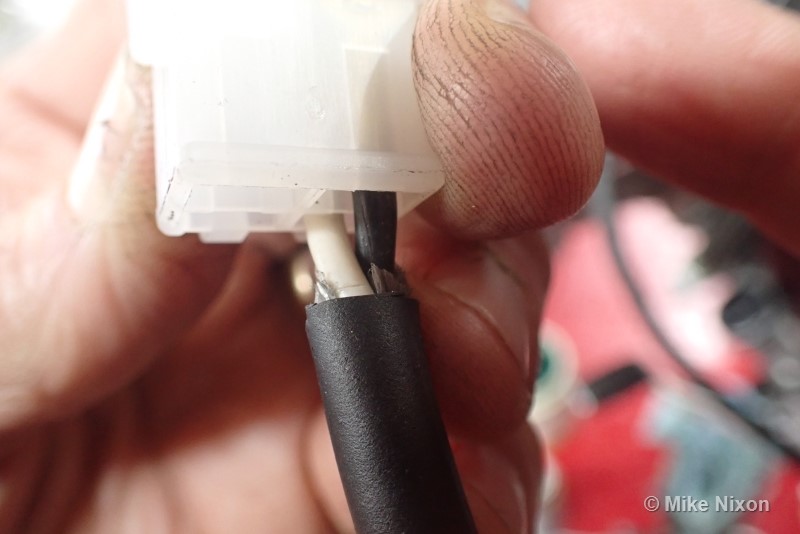 |
The colors change partway out of the unit. |
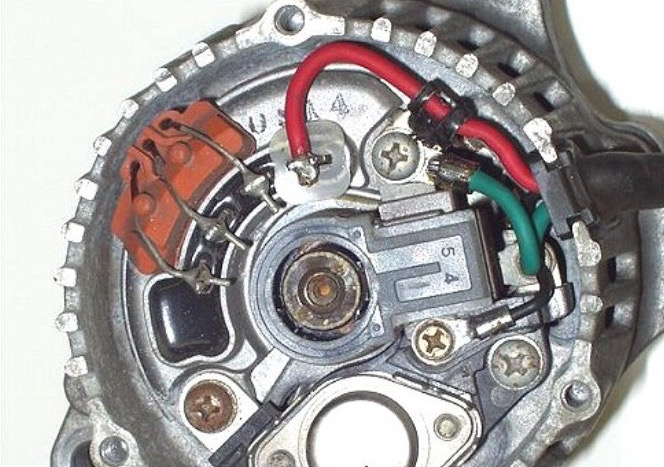 |
I found a picture of one person's installation that included rewiring with the correct Honda colors. More than that, he also added a ground wire, which is a very good idea. Electrical parts should not depend on physical grounds more than absolutely necessary. Note the heavier-than-usual wire gauge also. Good stuff. Thanks JR. |
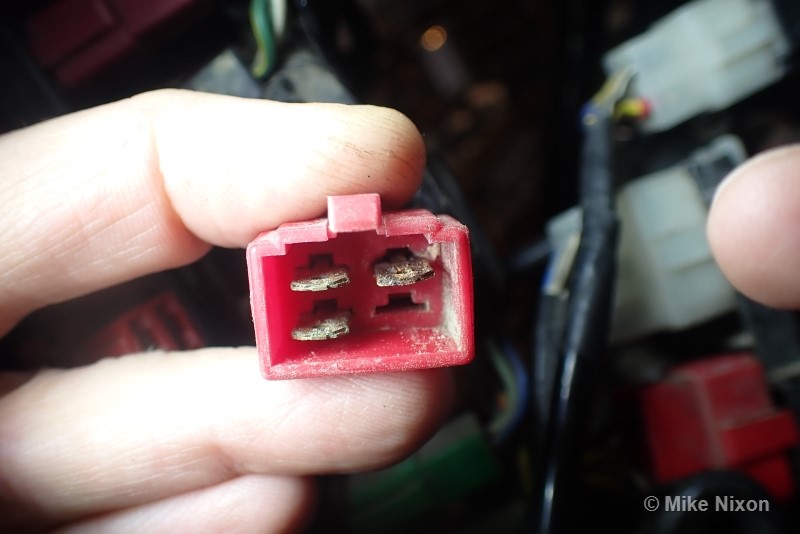 |
Here is the CBX harness-side connector the stock rectifier plugs into, so that the alternator's DC output is fed into the harness and on to the battery. As part of the Denso installation, this connector should be disassembled and serviced properly. It tends to be corroded. |
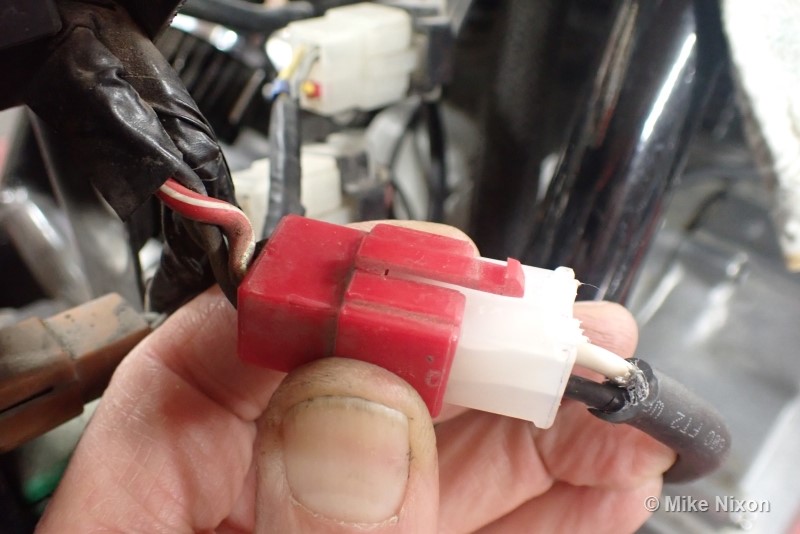 |
The conversion canon plug plugs right in. Nice. Note however that the locking tab had to be cut off. |
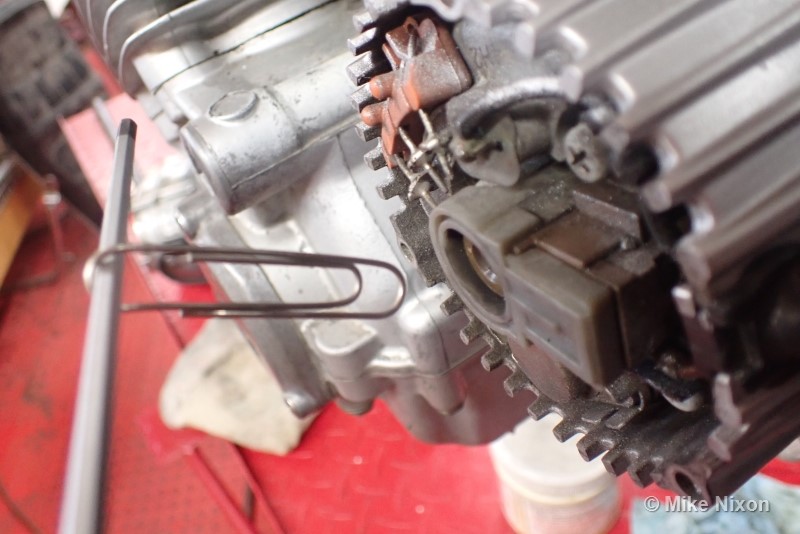 |
You don't need to do this, but it is a good and quick way to confirm that the wiring of the conversion is properly matched to the CBX wiring harness. Before even starting the bike, turn the keyswitch on and off, and each time the paper clip should swing hard toward the alternator, relax, then swing. This will work even with the cover on. |
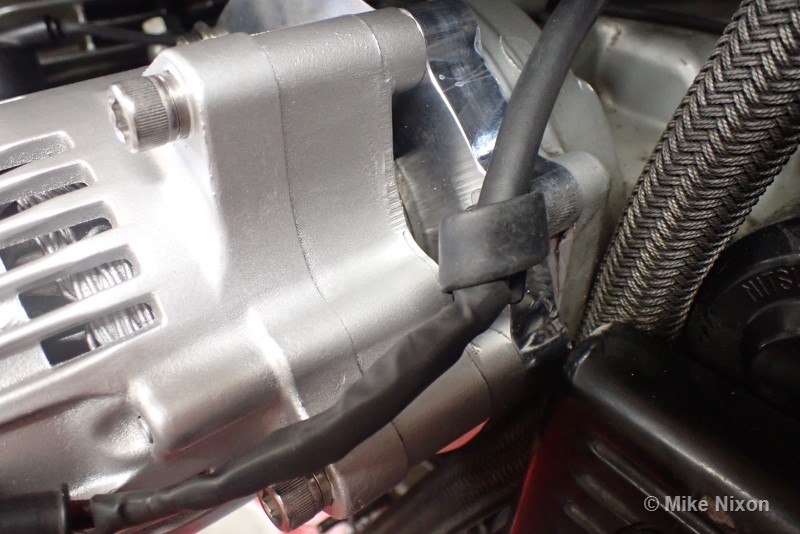 |
I added a wire retainer to tidy up the installation. The retainer should have come with the kit. No biggie. But an oversight in my view. |
|
There then are the facts. To be fair, my complaints are minor, and my objection to replacing the stock alternator is at the end of the day mostly philosophical. The Denso alternator conversion recorded here probably deserves a 9 or even a 9 1/2 out of 10. It works, and there are few if any meaningful drawbacks. Consider the unquestionably less expensive automotive-type replacement rectifier and regulator, plus longer brush life, and there is enough here to be appealing from an ease-of-maintenance standpoint. A lot of folks have bought these, and I can't fault the product if your approach to repair is to replace. And that is exactly where I have a problem. I don't believe in "new is better", or replacement as the default repair. And I don't like that CBX owners will, by being attracted to this product, be even less inclined to cultivate maintenance ethic than they already are, which is really too bad. Other than that, the Denso conversion's only negatives are minor ones introduced by inexpert conversion prep, plus its cost and lack of warranty. But even with its plusses, I'm still not convinced the Denso alternator conversion is preferable to properly servicing the stock system. Understand Honda's system, deal with its weaknesses, and along with most of us you'll enjoy a properly-functioning charging system. Or go the money route, if you must. Your choice. |
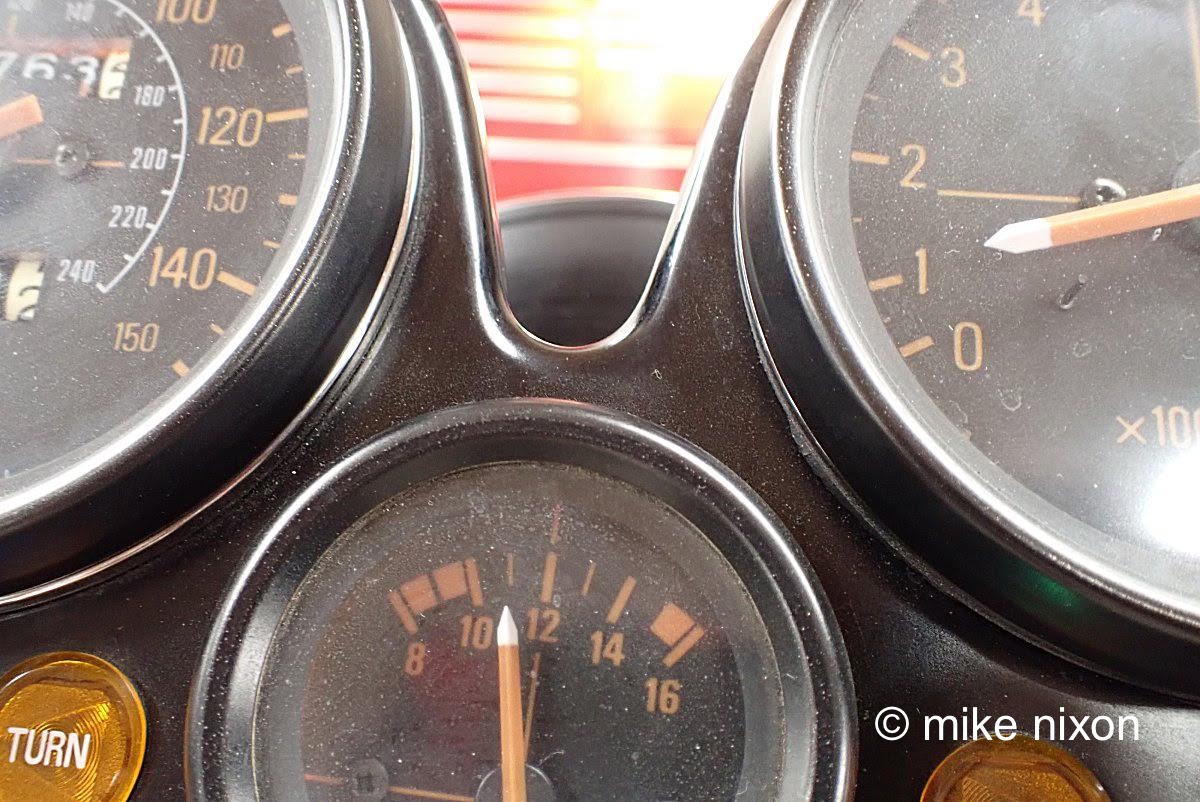 |
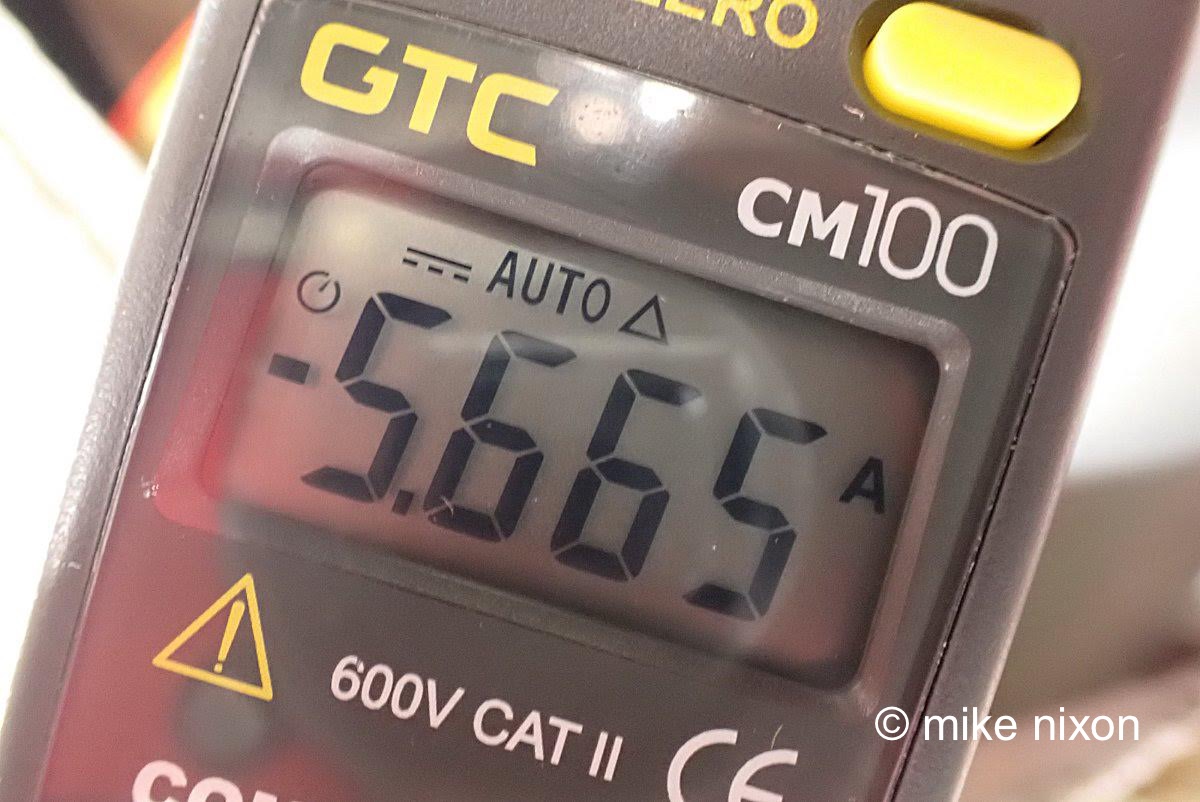 |
|
As mentioned above, in my experience, the claim that the Kawasaki alternator charges at idle is false. As you can see here, at the factory specified 1000 rpm, the voltmeter is still reading considerably below 12 volts. The system is below breakeven. |
A second, more accurate test was made using a VOM, and this test confirms the first one. The Kawasaki alternator does exactly the same as the stock one. It does not charge at idle. That's a 5.6A discharge, showing a below-breakeven state at idle, exactly the same as the stock system. |
|
Recommended reading: Email me © 1996-2022 Mike Nixon |
Theme by Danetsoft and Danang Probo Sayekti inspired by Maksimer

